The items listed below are a representative sample of the water bottle, mess tins, and other equipment that were designed to be attached to and carried by W.E., Patt. '37, but were not actually listed as part of this Pattern. There were many others, and as previously mentioned Karkee Web will be very pleased to list any and all other examples that may be supplied by our readers.
Aluminium and the British Army
The British Army had had brief forays into aluminium utensils, but always seemed half-hearted when compared to European armies of both the 19th and 20th Centuries. A German-made pattern water bottle was adopted in the Boer War, though it was short-lived for Ordinary Ranks. A contemporary author, a serving officer, stated in Scarlet Into Khaki that aluminium mess tins were also in service, though no documentary evidence has come to light. Aluminium, a comparatively new metal in the 1890s, was expensive and remained so until processed using hydro-electric power. It was one thing officers privately purchasing the German bottle, but for the Rank and File, this was a serious outlay, which must have had the War Office bean-counters all of a quiver!
When Pattern 1908 W.E. was introduced, the Fitting Instructions specifically stated that an aluminium bottle was included. It too was short-lived, along with the two aluminium bottles, of U.S. M-1910 form, that were introduced in the Great War. With regard to mess tins, none were of aluminium, so the Napoleonic era design served throughout the Great War and into the Second World War. The clothing and equipment trials of 1932-4 included a new aluminium mess-tin, for which the Two-Part Rucksack of the No. 3 Equipment catered.
Stores Ref. A1/AA 0341 Bottle, water, Mk. VII
Stores Ref. CN/AA 0341 Bottle, water, Mk. 7
Stores Ref. CN/AA 0343 Bottle, water, Mk. 7, without covers and stoppers, cork
Stores Ref. A1/AA 1670 Stoppers, cork, waterbottle, cords, short, 9-in., for Mk VII bottles
Stores Ref. A1/AA 1670 Stoppers, cork, water bottle, cords, short
Stores Ref. A1/AA 1671 Stoppers, cork, water bottle, cord
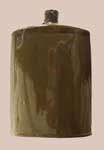
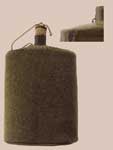 L. of C. B 3111, approved 29 November, 1939, introduced the Mark VII. This was slightly changed from the Mark VI in having a small wire “eye”, welded to the shoulder and neck of the bottle. A major change, from a practice dating back to 1888, was a switch from blue enamelling to green. Still with an eye on cost saving, the 1939 L. of C. introduced a shorter piece of string, namely Stoppers, cork, waterbottle, cords, short, 9-in., for Mk VII bottles – half the size of the old cord and now tied to the metal eye of the Mark VII. Evidently a case of Waste not want not. The drab cloth Cover was unchanged and Stopper, cork remained un-changed. The example shown here is from the John Bodsworth Collection. Photographs © John Bodsworth 2009.
L. of C. B 3111, approved 29 November, 1939, introduced the Mark VII. This was slightly changed from the Mark VI in having a small wire “eye”, welded to the shoulder and neck of the bottle. A major change, from a practice dating back to 1888, was a switch from blue enamelling to green. Still with an eye on cost saving, the 1939 L. of C. introduced a shorter piece of string, namely Stoppers, cork, waterbottle, cords, short, 9-in., for Mk VII bottles – half the size of the old cord and now tied to the metal eye of the Mark VII. Evidently a case of Waste not want not. The drab cloth Cover was unchanged and Stopper, cork remained un-changed. The example shown here is from the John Bodsworth Collection. Photographs © John Bodsworth 2009.
L. of C. B 3447, whose approval was un-dated (c.1940, q.v. L. of C. B 3446) made the two lengths of stopper cord obsolescent, instead introducing Stoppers, cork, water bottle, cord, which was now quantified as “Approx. 240-yds. to 1-lb.”
Stores Ref. A1/AA unknown* Bottle, water, aluminium
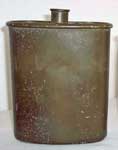
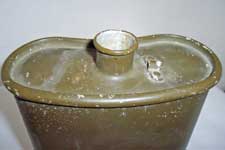
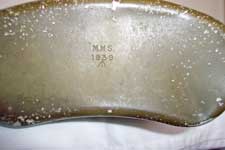 No introductory L. of C. has been noted, but an A.C.I. notifying withdrawal uses the above nomenclature. Its Service life was brief. Before 1939, the Army was undergoing extensive modernisation and had adopted an aluminium bottle, of Mark VI form, but with a flat form of “tin can” top. The stopper was the standard cork type, used on Marks IV to VI, but its Cord was tied to an aluminium staple, riveted to the shoulder of the bottle. The bottle had no Cover and was simply painted khaki. The example shown here is maker marked "M.M.S." and dated 1939. From the John Bodsworth Collection. Photographs © John Bodsworth 2009.
No introductory L. of C. has been noted, but an A.C.I. notifying withdrawal uses the above nomenclature. Its Service life was brief. Before 1939, the Army was undergoing extensive modernisation and had adopted an aluminium bottle, of Mark VI form, but with a flat form of “tin can” top. The stopper was the standard cork type, used on Marks IV to VI, but its Cord was tied to an aluminium staple, riveted to the shoulder of the bottle. The bottle had no Cover and was simply painted khaki. The example shown here is maker marked "M.M.S." and dated 1939. From the John Bodsworth Collection. Photographs © John Bodsworth 2009.
Despite the national campaign for housewives to surrender their aluminium cookware, photographs show that the Army still had their aluminium bottles as late as 1941, until ACI 962/1941 withdrew these, as part of the aluminium salvage drive. As a point of interest, the scheme was touted as helping to build aircraft. In fact, the aluminium was unsuitable for that purpose, but the scheme at least served to make the civilian population feel they were “doing their bit”!
* A1/AA 0342, the next in sequence, was actually another Bottle, water, aluminium, this being the U.S. inspired version used with Patt. ’44 W.E. Since the earlier bottle, of Mark VI/VII shape had been withdrawn for the aluminium salvage scheme, it could be that the code was re-used, though no instance of this has ever been noted in Army coding, though the R.A.F. had instances. If code AA 0339 was vacant, no use having being noted, it would be logical as Bottle, water, aluminium would precede Bottle, water, Mk. VI in an alphabetical sequence.
Stores Ref. A1/AA 5226 Tins, mess
Stores Ref. A1/AA 5226 Tins, mess, rectangular
Stores Ref. A1/AA 5084 Cover, mess-tin
Stores Ref. A1/AA 5084 Cover, mess-tin, rectangular
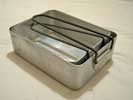
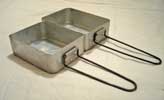
 When Patt. ’37 W.E. was introduced, the Haversack was specially divided to allow carriage of a new Mess tin. L. of C. B1624, approved in 1938, mentions a rectangular Mess tin, but it was not until B2537, approved 27th April 1939, that the new Mess tin was announced! Called simply Tins, mess the sub-detail added “…rectangular, aluminium, complete…”. It comprised Bodies, inner and Bodies, outer, one being smaller and nested inside the larger. The steel handles folded over the top of each Body and the assembly fitted inside a khaki, cotton drill Cover, mess-tin, rectangular (See below), which was announced in the same L. of C.. The example shown here, from the Chris Pollendine Collection, is maker marked "N.C.J. Ltd." (N.C. Joseph, Stratford Upon Avon) and dated 1939. Photographs © Chris Pollendine 2009.
When Patt. ’37 W.E. was introduced, the Haversack was specially divided to allow carriage of a new Mess tin. L. of C. B1624, approved in 1938, mentions a rectangular Mess tin, but it was not until B2537, approved 27th April 1939, that the new Mess tin was announced! Called simply Tins, mess the sub-detail added “…rectangular, aluminium, complete…”. It comprised Bodies, inner and Bodies, outer, one being smaller and nested inside the larger. The steel handles folded over the top of each Body and the assembly fitted inside a khaki, cotton drill Cover, mess-tin, rectangular (See below), which was announced in the same L. of C.. The example shown here, from the Chris Pollendine Collection, is maker marked "N.C.J. Ltd." (N.C. Joseph, Stratford Upon Avon) and dated 1939. Photographs © Chris Pollendine 2009.
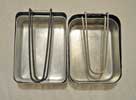 As the Second World War got under way, all was going well, L. of C. B4510 changing nomenclatures to Tins, mess, rectangular, adding “…rectangular…” to the Cover as well. Then a drive for aluminium salvage signalled the end, once again, for aluminium in the Army. A.C.I. 962/1941 withdrew both the aluminium Water bottle and its counterpart Mess tins. The coding of this item is of interest, since it shows the 5000 series of codes was initiated pre-war. In the photo at right, the 1939 A1/AA 5226 Tin, mess ( At left in the photo) is compared with the later aluminium version, A1/AA 5880. As can be seen, the earlier example is slightly larger (3/16-inch in length, 1/8-inch in width, 1/8-inch in height. The large pan handle on the late one is 1 1/2-inch shorter than the '39 one; the smaller pan handle shorter by 1-inch). The earlier version also has a much smaller radius at the corners, making is noticeably more "squared off". Note also the attachment of the handle, with three rivets through a piece of aluminium folded in a sandwich around the handle ends. Again, from the Chris Pollendine Collection, photograph © Chris Pollendine 2009.
As the Second World War got under way, all was going well, L. of C. B4510 changing nomenclatures to Tins, mess, rectangular, adding “…rectangular…” to the Cover as well. Then a drive for aluminium salvage signalled the end, once again, for aluminium in the Army. A.C.I. 962/1941 withdrew both the aluminium Water bottle and its counterpart Mess tins. The coding of this item is of interest, since it shows the 5000 series of codes was initiated pre-war. In the photo at right, the 1939 A1/AA 5226 Tin, mess ( At left in the photo) is compared with the later aluminium version, A1/AA 5880. As can be seen, the earlier example is slightly larger (3/16-inch in length, 1/8-inch in width, 1/8-inch in height. The large pan handle on the late one is 1 1/2-inch shorter than the '39 one; the smaller pan handle shorter by 1-inch). The earlier version also has a much smaller radius at the corners, making is noticeably more "squared off". Note also the attachment of the handle, with three rivets through a piece of aluminium folded in a sandwich around the handle ends. Again, from the Chris Pollendine Collection, photograph © Chris Pollendine 2009.
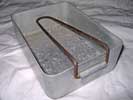
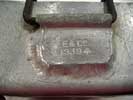 A second example of a 1939 dated mess tin has been forwarded. This has the handle “hinge” welded onto the body of the mess tin. As the manufacturer has not included a month of manufacture (see Steel Mess Tins below), it was initially impossible to establish which of these 1st Issue tins was first. A known example, manufactured in the U.K. in 1936, but for the South Africa Army, does not employ welding, although the hinge is constructed differently. Chris Pollendine has quantified just how difficult it is to weld aluminium. It was therefore felt that the welded version came first and was superseded by the riveted type, which would have been far quicker to make. This is now supported by the example below, from Robert Ball. There might be manufacturing variations, between companies, but given the choice of welding or riveting, it would be a strange manufacturer that chose the more difficult process. However, for absolute proof, the two types – made by one company – would prove the progression. As the type was withdrawn, insufficient examples and markings have been seen, as yet. Marked E & Co, it comes from the Pete Woldridge Collection, photo © 2009 via Sean Featherstone.
A second example of a 1939 dated mess tin has been forwarded. This has the handle “hinge” welded onto the body of the mess tin. As the manufacturer has not included a month of manufacture (see Steel Mess Tins below), it was initially impossible to establish which of these 1st Issue tins was first. A known example, manufactured in the U.K. in 1936, but for the South Africa Army, does not employ welding, although the hinge is constructed differently. Chris Pollendine has quantified just how difficult it is to weld aluminium. It was therefore felt that the welded version came first and was superseded by the riveted type, which would have been far quicker to make. This is now supported by the example below, from Robert Ball. There might be manufacturing variations, between companies, but given the choice of welding or riveting, it would be a strange manufacturer that chose the more difficult process. However, for absolute proof, the two types – made by one company – would prove the progression. As the type was withdrawn, insufficient examples and markings have been seen, as yet. Marked E & Co, it comes from the Pete Woldridge Collection, photo © 2009 via Sean Featherstone.
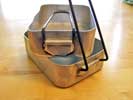
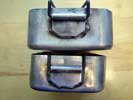
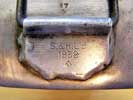 Photographs of another welded example have now been received. Although from a different company, S & H Ltd (Sellman & Hill Ltd., Crescent Works, Woverhampton), it is dated 1938 so supports the contention that the 1st Issues were welded. From the collection of Robert Ball. Photographs © Robert Ball, 2009.
Photographs of another welded example have now been received. Although from a different company, S & H Ltd (Sellman & Hill Ltd., Crescent Works, Woverhampton), it is dated 1938 so supports the contention that the 1st Issues were welded. From the collection of Robert Ball. Photographs © Robert Ball, 2009.
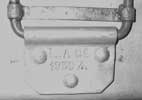
 A third variation has also been noted. On the examples above, the handles are bent into shape and are not otherwise secured behind the hinge plate. On the example at right, from the Chris Pollendine Collection, metal straps have been added across the handle, to ensure they cannot be bent out of place. This tin is maker marked "L.A. Co." (London Aluminium Co.) and dated 1939. Photos © Chris Pollendine 2009.
A third variation has also been noted. On the examples above, the handles are bent into shape and are not otherwise secured behind the hinge plate. On the example at right, from the Chris Pollendine Collection, metal straps have been added across the handle, to ensure they cannot be bent out of place. This tin is maker marked "L.A. Co." (London Aluminium Co.) and dated 1939. Photos © Chris Pollendine 2009.
Stores Ref. A1/AA 5231 Tins, mess, rectangular, mild steel
Stores Ref. CN 1877 Tins, mess, rectangular, mild steel
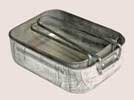
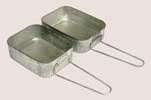
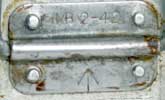 With the aluminium tin withdrawn, a mild steel version was introduced, but was Not In Vocabulary until October 1945. These were an identical design, tinned for protection and with a prominent repousse rib along the upper part of the long edges. The outer (larger) tin had a rib pressed outwards, the inner tin had the rib formed on its inner face. Later issues would dispense with these ribs, in order to simplify manufacture. The first documented mention found is in L. of C. C1757, which introduced a new aluminium design, made the withdrawn aluminium version obsolete and simultaneously introduced the Tins, mess, rectangular, mild steel and made them obsolescent. The 1951 L. of C. C4686 still listed the mild steel version and re-coded it under Section CN of the Catalogue of Clothing and Necessaries (C.C.N.). It is a moot point, but the existence of L. of C. C 1757 meant it did not appear as Not In Vocabulary (N.I.V.), which it had been for the entire duration of the War! L. of C. C 7088, with approval dates of 13 Feb 1954 / 24 Nov 1955, finally made the steel mess tin obsolete. By the 1965 edition of the C.C.N., only the 2nd Issue aluminium type remained. The example shown here is maker marked "MB" (Metal Box Ltd.) and dated February 1942. From the John Bodsworth Collection. Photographs © John Bodsworth 2009.
With the aluminium tin withdrawn, a mild steel version was introduced, but was Not In Vocabulary until October 1945. These were an identical design, tinned for protection and with a prominent repousse rib along the upper part of the long edges. The outer (larger) tin had a rib pressed outwards, the inner tin had the rib formed on its inner face. Later issues would dispense with these ribs, in order to simplify manufacture. The first documented mention found is in L. of C. C1757, which introduced a new aluminium design, made the withdrawn aluminium version obsolete and simultaneously introduced the Tins, mess, rectangular, mild steel and made them obsolescent. The 1951 L. of C. C4686 still listed the mild steel version and re-coded it under Section CN of the Catalogue of Clothing and Necessaries (C.C.N.). It is a moot point, but the existence of L. of C. C 1757 meant it did not appear as Not In Vocabulary (N.I.V.), which it had been for the entire duration of the War! L. of C. C 7088, with approval dates of 13 Feb 1954 / 24 Nov 1955, finally made the steel mess tin obsolete. By the 1965 edition of the C.C.N., only the 2nd Issue aluminium type remained. The example shown here is maker marked "MB" (Metal Box Ltd.) and dated February 1942. From the John Bodsworth Collection. Photographs © John Bodsworth 2009.
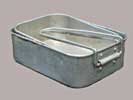
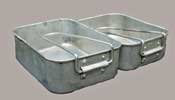 A later issue example of the Tins, mess, rectangular, mild steel, without the formed ribs mentioned above. This example is not maker marked or dated. From the Nick Wall Collection, photographs © Nick Wall 2009.
A later issue example of the Tins, mess, rectangular, mild steel, without the formed ribs mentioned above. This example is not maker marked or dated. From the Nick Wall Collection, photographs © Nick Wall 2009.
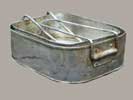
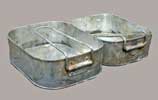
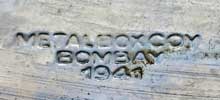 Another example of the steel Mess tin, again the version with no rib, but also made with separate bases, obviating the need for presses. Interestingly, this example is maker marked "Metal Box Coy / Bombay" and dated 1941. From the Nick Wall Collection, photographs © Nick Wall 2009.
Another example of the steel Mess tin, again the version with no rib, but also made with separate bases, obviating the need for presses. Interestingly, this example is maker marked "Metal Box Coy / Bombay" and dated 1941. From the Nick Wall Collection, photographs © Nick Wall 2009.
Stores Ref. A6/AF 0225 Tins, mess, rectangular, aluminium
Stores Ref. A1/AA 5880 Tins, mess, rectangular, aluminium
Stores Ref. CN 1876 Tins, mess, rectangular
Stores Ref. 7350-99-973-6265 Pans, mess set
Stores Ref. 7350-99-973-6265 Pans, mess kit
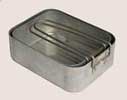
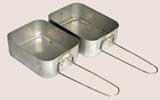
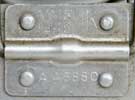 The campaign in the Far East meant a range of new equipment was introduced, as Section A6 Jungle Warfare Equipment. It included A6/AF 0225 Tins, mess, rectangular, aluminium, which formed part of the issue kit for use with Patt. ’44 W.E. L. of C. C 1757 transferred this new mess tin to V.A.O.S. Section A1 as a “…standard mess tin for all Services…”, with a change in its stores code. The dimensions (7 3/32 inches long, 5 9/32 inches wide and 2 23/64 inches deep) were stated as reduced – presumably its height – the handles were now of aluminium alloy and the body was made from 1 ¼ % manganese. In 1951, L. of C. C 4686 transferred V.A.O.S. Section A1 to C.C.N. Section CN and the mess tins acquired a new code CN 1876. The 1965 edition of C.C.N. curiously makes it a singular Tin, mess, rectangular, but by 1976, Section CN of what was now the Catalogue of Ordnance Stores and Ammunition (C.O.S.A.) has gone slightly American, now calling them Pans, whilst the 1999 edition has inexplicably changed set to kit. Confusingly, to my mind, Mess kit is the rather snazzy Nos. 10 and 11 Orders of Dress, in which O.R.s and Officers cut a dash on Dining-In nights! This piece of aluminium is still in service with the British Army today – an un-broken 65 years of service for an aluminium artefact – finally. The example shown here is maker marked "M.M.S." (Midland Metal Spinning Co, or sometimes Midland Metal Spinners) and dated 1945. From the John Bodsworth Collection. Photographs © John Bodsworth 2009.
The campaign in the Far East meant a range of new equipment was introduced, as Section A6 Jungle Warfare Equipment. It included A6/AF 0225 Tins, mess, rectangular, aluminium, which formed part of the issue kit for use with Patt. ’44 W.E. L. of C. C 1757 transferred this new mess tin to V.A.O.S. Section A1 as a “…standard mess tin for all Services…”, with a change in its stores code. The dimensions (7 3/32 inches long, 5 9/32 inches wide and 2 23/64 inches deep) were stated as reduced – presumably its height – the handles were now of aluminium alloy and the body was made from 1 ¼ % manganese. In 1951, L. of C. C 4686 transferred V.A.O.S. Section A1 to C.C.N. Section CN and the mess tins acquired a new code CN 1876. The 1965 edition of C.C.N. curiously makes it a singular Tin, mess, rectangular, but by 1976, Section CN of what was now the Catalogue of Ordnance Stores and Ammunition (C.O.S.A.) has gone slightly American, now calling them Pans, whilst the 1999 edition has inexplicably changed set to kit. Confusingly, to my mind, Mess kit is the rather snazzy Nos. 10 and 11 Orders of Dress, in which O.R.s and Officers cut a dash on Dining-In nights! This piece of aluminium is still in service with the British Army today – an un-broken 65 years of service for an aluminium artefact – finally. The example shown here is maker marked "M.M.S." (Midland Metal Spinning Co, or sometimes Midland Metal Spinners) and dated 1945. From the John Bodsworth Collection. Photographs © John Bodsworth 2009.
It is also still dimensioned in Imperial units, amidst all too many metric military measurements. Lovely stuff and a triumph over the b-EURO-crats.
Stores Ref. A1/AA 5084 Cover, mess-tin
Stores Ref. A1/AA 5084 Cover, mess-tin, rectangular
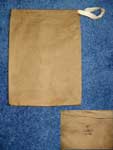 From Napoleonic times, Mess tins had Covers, originally in lacquered canvas, then oilskin. In the 20th century, these changed to Khaki Drill material and like cloths. When L. of C. B 2537 introduced the new aluminium Mess tin, for use with Patt. ’37 W.E., it also authorised a Cover, made from Khaki Drill material. It was a simple bag, with top closed by a white draw-tape. L. of C. B 4510, approved c. 1941, amended the nomenclature, adding “…, rectangular…”. After this A.C.I. 179/1941 (not to hand) withdrew the Cover from equipment issues. The reasons are not known, but it is likely that it was a wartime economy, to save material and manufacturing time. L. of C. B 5405, approved 8 September 1941, confirmed that it was now obsolete and added that existing stocks were to be used up as Ration bags. The example shown left is maker marked "Belida Ltd." and dated 1939. From the Allen Prior Collection. Photographs © Allen Prior 2009.
From Napoleonic times, Mess tins had Covers, originally in lacquered canvas, then oilskin. In the 20th century, these changed to Khaki Drill material and like cloths. When L. of C. B 2537 introduced the new aluminium Mess tin, for use with Patt. ’37 W.E., it also authorised a Cover, made from Khaki Drill material. It was a simple bag, with top closed by a white draw-tape. L. of C. B 4510, approved c. 1941, amended the nomenclature, adding “…, rectangular…”. After this A.C.I. 179/1941 (not to hand) withdrew the Cover from equipment issues. The reasons are not known, but it is likely that it was a wartime economy, to save material and manufacturing time. L. of C. B 5405, approved 8 September 1941, confirmed that it was now obsolete and added that existing stocks were to be used up as Ration bags. The example shown left is maker marked "Belida Ltd." and dated 1939. From the Allen Prior Collection. Photographs © Allen Prior 2009.
Stores Ref. A6/AF 0040 Cover, mess tin
Stores Ref. A1/AA 0779 Cover, mess-tin, rectangular
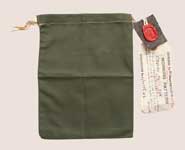
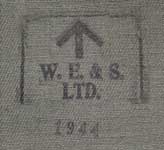 When Pattern 1944 Web Equipment was introduced, a re-think had taken place and a new Cover was introduced to V.A.O.S. Section A6, Jungle Warfare Equipment. This was in cotton drill material, dyed to S.C.C. 19, in other words dark green and was identical to the khaki drill version, but retained the white tie tape. In October 1945, L. of C. C 1757 transferred the second pattern of aluminium Mess tins (developed specifically for jungle warfare) from Section A6 to Section A1, so that it became a General service issue. Though no L. of C. for the Cover has been noted, a Sealed Pattern from the John Bodsworth Collection shows it was also transferred, acquiring a new stores code in the process. This bag is maker marked "W.E. & S. LTD." (William Ewart & Son, Belfast) and dated 1944. Photographs © John Bodsworth 2009.
When Pattern 1944 Web Equipment was introduced, a re-think had taken place and a new Cover was introduced to V.A.O.S. Section A6, Jungle Warfare Equipment. This was in cotton drill material, dyed to S.C.C. 19, in other words dark green and was identical to the khaki drill version, but retained the white tie tape. In October 1945, L. of C. C 1757 transferred the second pattern of aluminium Mess tins (developed specifically for jungle warfare) from Section A6 to Section A1, so that it became a General service issue. Though no L. of C. for the Cover has been noted, a Sealed Pattern from the John Bodsworth Collection shows it was also transferred, acquiring a new stores code in the process. This bag is maker marked "W.E. & S. LTD." (William Ewart & Son, Belfast) and dated 1944. Photographs © John Bodsworth 2009.
Stores Ref. A1/AA 0106 Bag, ration, Mk. III
Stores Ref. A1/AA 0106 Bag, ration, Mk. 3
Ration bags were introduced with the japanned canvas Mark I in 1913, a simplified Mark II, in calico, being introduced in 1914. Comment was added that the Bag was “…for the carriage of the biscuits which form part of the iron ration…”. The Mark III was introduced by L. of C. 19145, approved on 23 July 1917. Still made of calico, it was reduced in size to 10 ½ by 7 ½ inches. As ever, stocks of Mark II Bags were to be used up. The Mark III was still listed in L. of C. C4686 in 1951, now as the Arabic form, Mark 3, being made obsolete sometime before 1976.
Stores Ref. A1/AA 0107 Bag, ration, Mk. IV
Stores Ref. CN/AA 0107 Bag, ration, Mk. 4
Stores Ref. CN 8465-99-973-6476 Bag, ration
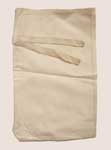
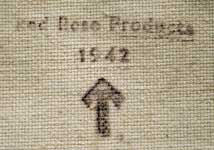 L. of C. 21560, approved on 3rd November 1918, introduced the Mark IV, which had slightly increased dimensions, 12 ¾ inches long by 7 ¾ inches wide and still made of calico. A tie-tape was stitched part way down from the mouth of the bag, so that the mouth could be gathered up and tied.
L. of C. 21560, approved on 3rd November 1918, introduced the Mark IV, which had slightly increased dimensions, 12 ¾ inches long by 7 ¾ inches wide and still made of calico. A tie-tape was stitched part way down from the mouth of the bag, so that the mouth could be gathered up and tied.
Surprisingly, it survived into the era of the individual 24 Hour G.S. Ration Pack, where all the contents were vacuum packed in foil. The Mark 3 having been made obsolete, the Mark 4 designation was dropped and its last listing was in the 1995 edition of the C.O.S.A.. It had been made obsolete by 1999. This example is maker marked "Red Rose Products" and dated 1942. From the John Bodsworth Collection. Photographs © John Bodsworth 2009.